
The standard-winged nightjar is a nocturnal bird in the nightjar family.

Jerdon's nightjar is a medium-sized nightjar species native to southern India and Sri Lanka. Formerly considered as a subspecies of the long-tailed nightjar, it is best recognized by its distinctive call which sounds like a wooden plank being beaten periodically with each note ending in a quaver. The common name commemorates Thomas C. Jerdon who described the species.
Prigogine's nightjar or the Itombwe nightjar, is a bird species of tropical central Africa. It is known from only one specimen taken at Malenge in the Itombwe Mountains in Zaire in August 1955.
Mees's nightjar is a member of the nightjar family (Caprimulgidae) described as new to science in 2004.
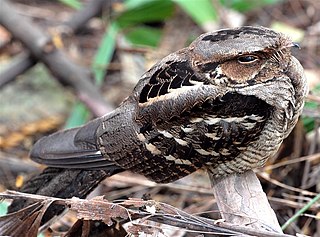
Caprimulgus is a large and very widespread genus of nightjars, medium-sized nocturnal birds with long pointed wings, short legs and short bills. Caprimulgus is derived from the Latin capra, "nanny goat", and mulgere, "to milk", referring to an old myth that nightjars suck milk from goats. The common name "nightjar", first recorded in 1630, refers to the nocturnal habits of the bird, the second part of the name deriving from the distinctive churring song.

The Sykes's nightjar, Sykes' nightjar, Sind nightjar or Sindh nightjar is a nightjar species found in northwestern South Asia.

The savanna nightjar, also known as allied nightjar or Franklin's nightjar, is a species of nightjar found in South and Southeast Asia. Six subspecies are recognised: C. a. monticolus, C. a. amoyensis, C. a. stictomus, C. a. affinis, C. a. timorensis and C. a. propinquus. It was once considered conspecific with the chirruping nightjar. The IUCN Red List has assessed the species to be of least concern because it has a large range and its population trend is stable.

Arthur Donaldson Smith was an American explorer of East Africa. In 1894 and 1895, he led an expedition to Lake Rudolf and collect botanical, geological and zoological samples for scientific study which traversed 4,000 miles through British Somaliland, southern Ethiopia and Kenya. In 1897 he published a book about his travels, Through Unknown African Countries: the First Expedition from Somaliland to Lake Rudolf. He was a member of the American Philosophical Society and a Fellow of the Royal Geographic Society. Three species of reptiles, three birds and a desert musk shrew were named in his honor.

The slender-tailed nightjar is a species of nightjar in the family Caprimulgidae. It is found in Democratic Republic of the Congo, Ethiopia, Kenya, Somalia, South Sudan, Tanzania, and Uganda.

The golden nightjar is a species of nightjar in the family Caprimulgidae. It is found in Sahel region in northern Sub-Saharan Africa.
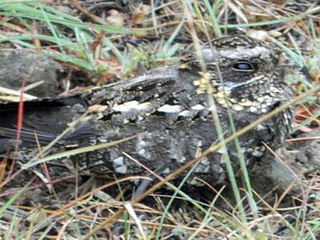
The sombre nightjar or dusky nightjar is a species of nightjar in the family Caprimulgidae. It is native to East Africa.

The large-tailed nightjar is a species of nightjar in the family Caprimulgidae. It is found along the southern Himalayan foothills, eastern South Asia, Southeast Asia and northern Australia. This species is a resident of the countries of Australia, Bangladesh, Bhutan, Brunei, Cambodia, China, India, Indonesia, Laos, Malaysia, Myanmar, Nepal, Pakistan, Papua New Guinea, Philippines, Singapore, Thailand, Timor-Leste and Vietnam. Its natural habitats are subtropical or tropical moist lowland forest, subtropical or tropical mangrove forest, and subtropical or tropical moist montane forest.
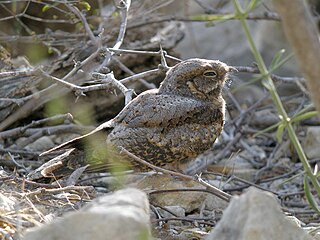
The Madagascar nightjar or Madagascan nightjar is a species of nightjar in the family Caprimulgidae. It is native to Madagascar, Nosy Boraha and Aldabra. Its natural habitats are subtropical or tropical moist lowland forest and subtropical or tropical moist montane forest.
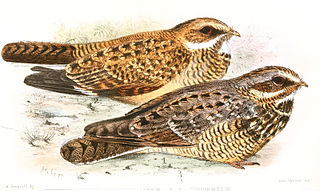
The swamp nightjar or Natal nightjar is a crepuscular and nocturnal bird in the nightjar family found in Africa.

The Nubian nightjar is a species of nightjar in the family Caprimulgidae. It is found in salt marshes of Djibouti, Egypt, Eritrea, Ethiopia, Israel, Kenya, Oman, Saudi Arabia, Somalia, Sudan, and Yemen.

The fiery-necked nightjar is a species of nightjar in the family Caprimulgidae, which is found mostly in Africa south of the equator, though it has been spotted in a few countries north of the equator. It is most often found in woodland savannas or other deciduous woodlands. It is usually distinguished by its tawny coloured collar which gives the species its common name. It has a distinctive call that many have rendered as 'good-lord-deliver-us'. The fiery-necked nightjar is an insectivorous species that mostly eats butterflies, moths and other insects. The fiery-necked nightjar breeds after the dry season and typically produce two clutches with two eggs per clutch.

The montane nightjar, mountain nightjar or Abyssinian nightjar, is a species of nightjar in the family Caprimulgidae. It is native to upland regions of Central and Eastern Africa where it is a locally common species.

Donaldson Smith's sparrow-weaver is a species of bird in the family Ploceidae. It is found in Africa from southern Ethiopia to central Kenya and southern Somalia. It was named in honor of the 19th-century American explorer Arthur Donaldson Smith.

The Andaman nightjar is a species of nightjar found in the Andaman Islands. It is sometimes considered a subspecies of the large-tailed nightjar, however the song and morphology are distinct.
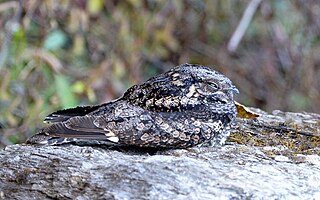
The grey nightjar or gray nightjar is a species of nightjar found in East Asia. It is sometimes treated as a subspecies of the jungle nightjar, its South Asian relative. The grey nightjar, a nocturnal bird species, breeds and forages in early successional habitats surrounded bu forests; its populations have declined since the 1970s in Japan.


















